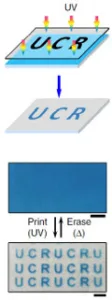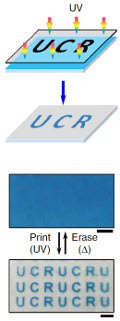A team in the Department of Chemistry at the University of California (Riverside, CA) lead by Wenshou Wang is developing rewriteable paper. It is based on the use of color-switching dyes and an ultra violet light to write an image on a physical medium.
At this time, the medium is either a glass or plastic film. The old image can be erased with the application of heat. Images can be repeatedly written and retained for days.
The most recent article on the subject published by the team is entitled “Photocatalytic colour switching of redox dyes for ink-free light-printable rewriteable paper”. It was published in Nature Communications, 2014; 5: 5459. A copy of the article is available for purchase here.
The rewriteable paper is based on the color switching property of three commercially available chemicals. These are the primary colors produced from redox dyes methylene blue, neutral red and acid green. Included in the dye are titania nanocrystals that serve as a catalyst and the thickening agent hydrogen cellulose (HEC). The combination of the dye, catalysts and HEC lends high reversibility and repeatability to the film.
The dye forms the imaging layer of the paper. During the writing phase the ultraviolet light reduces or photobleaches the dye to its colorless state except those areas that make up the image on the paper. During the erasing phase, re-oxidation of the reduced dye recovers the original color. That is, the imaging material recovers its original color by reacting with ambient oxygen. Heating at 115 oC can speed up the reaction so that the erasing process is often completed in less than 10 minutes.
The current version of the rewriteable paper can be erased and written on more than 20 times with no significant loss in contrast or resolution. The printed image remains legible with high resolution at ambient conditions for more than three days. This is represented as long enough for practical applications such as reading newspapers.
Since the new rewriteable paper does not require additional inks for printing, it is claimed to be both economical and environmentally viable. In addition, the rewritable paper is claimed to be simple to make, inexpensive to produce and have low toxicity and energy consumption.
The team is currently working on a paper version of the rewritable paper. One of the team members stated that “Even for this kind of paper, heating to 115 oC poses no problem. In conventional laser printers, paper is already heated to 200 oC in order to get toner particles to bond to the paper surface”.
The team is also working to increase the number of times the rewritable paper can be written and erased. The target is 100 cycles. In addition, the team is exploring ways to extend the readability of images to more than three days so as to expand the range of potential uses of the rewritable paper.
Commenting on how these improvements could be accomplished, team member Yadong Yin stated that “One way is to develop new photocatalyst nanoparticles that become highly reductive when irradiated by ultraviolet light”. He went on to state that “We are exploring, too, the possibility of multi-color printing. The design principle can be extended to various commercial redox dyes to produce rewritable paper capable of showing prints of different colors”.
The team has recently synthesized a colloidal titania nanoparticle catalyst doped with barium ions. This was found to enable reversible light-responsive color switching with excellent cycling performance and considerably high switching rate.
Yin explained that: “The improved performance is attributed to the more effective removal of the photogenerated oxidative holes that results from barium doping. This leaves more electrons for promoting the reduction of redox dyes”.
At this time, the University has filed a provisional US patent application for the technology. The UCR Office of Technology Commercialization is actively seeking a company to license the technology. – Arthur Berman
University of California, Wenshou Wang, 951-827-3429, [email protected]


